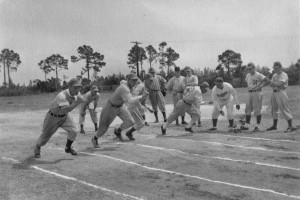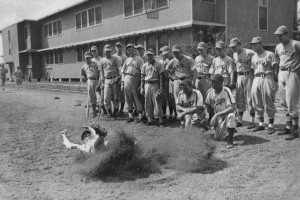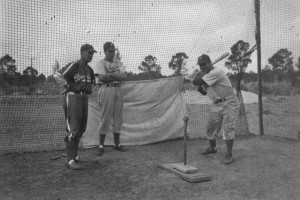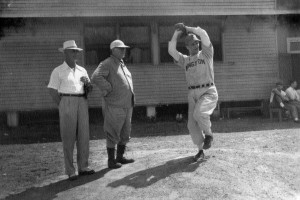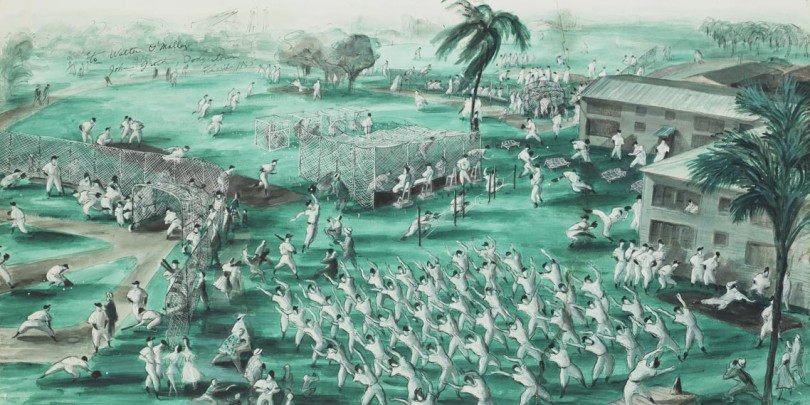
Feature
The O’Malley Family and Dodgertown: Championing Togetherness, Fostering Friendships and Advancing Equality
By Brent Shyer
Dating back to 1948, a little slice of heaven on earth known as “Dodgertown” in Vero Beach, Florida was directed by the O’Malley family for 58 of the last 76 years. The leadership of the O’Malley family in those seven decades at Dodgertown caused significant advances to take place in Major League Baseball history and society in general, as it always cultivated inclusiveness.
That’s an extraordinary run (1948-1998, 2012-18), but especially at a Spring Training site as magical, revered and respected as Dodgertown. This was no “cookie cutter” major league spring camp. No, Dodgertown was unique in its application and design. Togetherness and success developed at Dodgertown enabling all Dodger major and minor league players to train, play, dine and stay at one location. In addition, team executives, medical personnel, broadcasters, trainers, staff and media also all lived on “base” which gave the feeling of one large “family.” As an ideal setting for team preparation and unity, six Dodger teams reached the pinnacle in baseball with a World Championship during the O’Malley era including 1955, 1959, 1963, 1965, 1981 and 1988.
No other place in the world holds as many memories for me as Dodgertown.
Vin Scully
Dodgers’ Hall of Fame broadcaster for 67 years
Unless acquired during the season, every Dodger player – major and minor leaguer – from 1948-2008 trained at Dodgertown. A parade of talent routinely walked and played on these hallowed grounds. The baton was passed from Pee Wee Reese and Gil Hodges to Jackie Robinson, Duke Snider, and Roy Campanella; then to Sandy Koufax, Don Drysdale, and Don Sutton; to Steve Garvey and Fernando Valenzuela to Orel Hershiser; and then to Mike Piazza, Chan Ho Park, and Hideo Nomo; and finally to Clayton Kershaw.
Vin Scully, the Hall of Famer and greatest broadcaster ever, once said, “No other place in the world holds as many memories for me as Dodgertown.”
That is, in large part, because it was the starting point for each Dodger season and a brotherhood was formed as players, staff, executives, medical personnel and broadcasters interacted with each other on and off the fields from early morning to bedtime. The camaraderie nurtured numerous friendships and a special bond as training and preparation for the upcoming season was underway. A minor league player would stand next to a major league veteran or the team president waiting for a meal in the dining room buffet line. This was a way for barriers to be broken and fostered friendships.
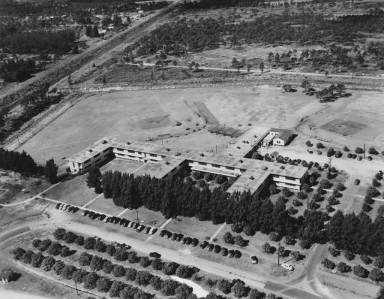
Before Walter O’Malley built a stadium for the Dodgers at Dodgertown, several more primitive fields were in use at the complex and available for practices and exhibition games.
Dodgertown’s rich tradition dates back to 1947, when the Dodgers learned of the facility from Bud Holman, representing the City of Vero Beach and its 3,000 residents, who expressed his desire to find a possible tenant for the land and barracks which had served as a U.S. Naval Air Station during World War II. In searching for a use for the 100 acres with its abandoned two-story, wooden barracks next to the airport, prominent business leader and Vero Beach Municipal Airport Manager Holman saw enormous potential and had an innovative idea. He inquired which baseball team had the largest minor league system and was told the Dodgers. Holman contacted Dodger President Branch Rickey about establishing training headquarters in Vero Beach. It was the perfect match, as Rickey wanted to create a “baseball college” to educate more than 650 players about the game, while keeping his scouts busy searching for quality talent to fill the 26 Dodger farm teams. The Dodgers inspected it: floors were creaky and weeds were growing – inside the barracks! There was no heating or air conditioning in the accommodations and many players would have to sleep six to a room with paper-thin walls. Bathrooms were “down the hall” and pipes frequently leaked. But, the potential was there and over time it became the perfect set-up for the organization. Thus, in 1948, the Dodgers found a new home for Spring Training, calling the spacious base “Dodgertown.”
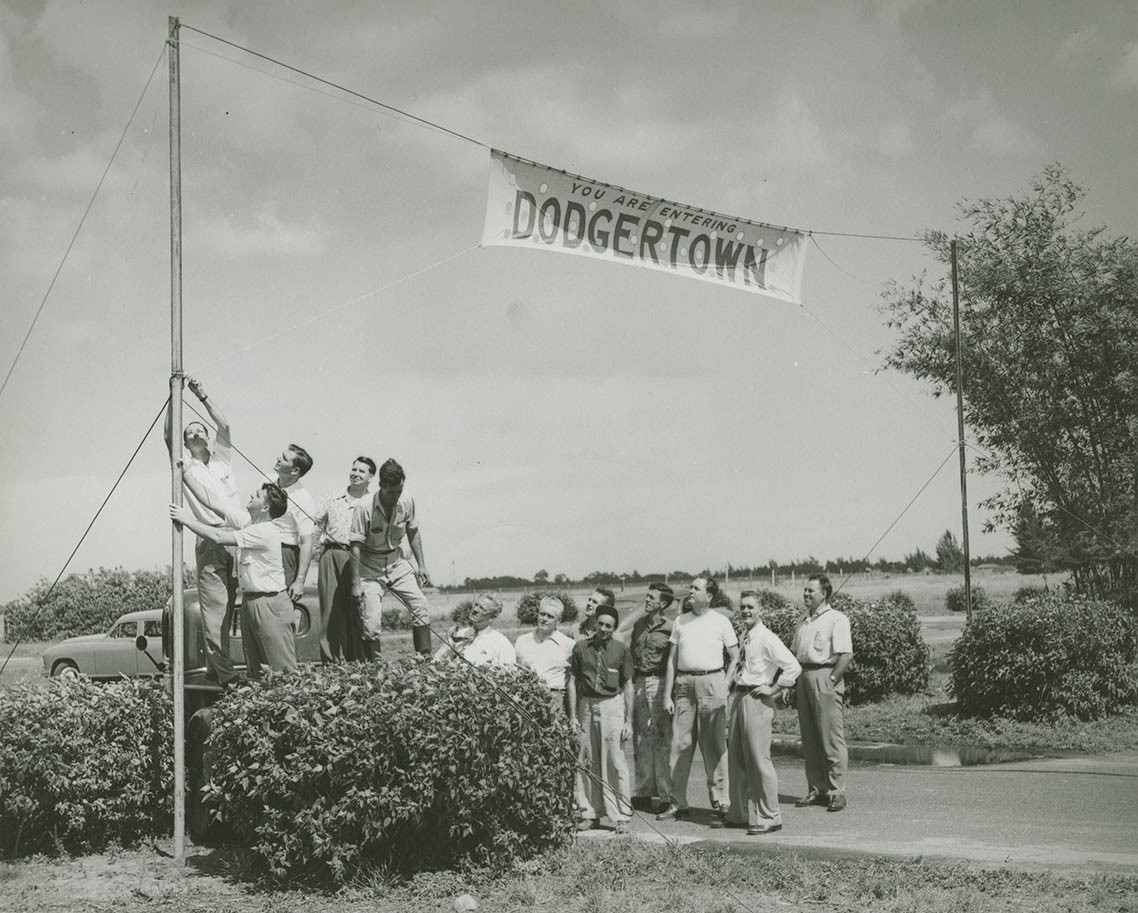
1948 Dodgertown employees raise a welcoming banner to everyone who is staying on the Dodgertown base in Vero Beach, Florida for Spring Training. The banner concept remained a Dodgertown tradition for players for the next 60 seasons. In 1948, it marked the first integrated Spring Training Camp for baseball in the South where all players, regardless of color, shared the same dining and living accommodations.
During World War II, the nearly 2500-acre base and adjacent streets were developed quickly in 1942 after the Vero Beach Municipal Airport was condemned for federal takeover, providing training grounds for 2,700 men and 300 WAVES & women Marines. Training was for night fighter and dive bomber pilots, as well as crewmen. Barracks were built to house the flyers and officers.
After the war ended, notice was given on May 10, 1946, that the airport and buildings would be turned over to Vero Beach and Indian River County. The base was transferred from the Navy on March 23, 1947, and on April 12 that year to the city with the stipulation from the U.S. Government under the terms “that any use of the facilities was subject to federal approval and any funds acquired from use or sale of the airbase property must be retained in a special fund and applied exclusively to the maintenance or development of flight facilities.” The last personnel were shipped out and the base closed August 23, 1947. City of Vero Beach website, “Vero Beach History”, 2021
Holman was one of a handful of residents who had originally established the airport in 1929. Born in Versailles, KY on September 18, 1900, Holman opened his successful Vero Beach Cadillac Company in 1925. In 1932, Holman had convinced Eastern Air Lines to make Vero’s airport a fueling stop. Holman and Postmaster J.J. Schumann were instrumental in obtaining direct air mail service for the community in 1935, making it the smallest U.S. city to have the service.
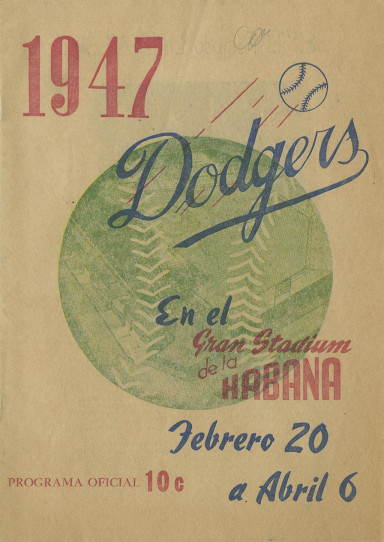
The front cover of the Brooklyn Dodgers’ program in Havana, Cuba when they trained there in 1947. Inside the program is a photograph of Jackie Robinson, reading a 1947 Brooklyn Dodger media guide. The Dodgers would end their Spring Training in Cuba on April 6th, and four days later, on April 10th, they announced they were bringing Jackie Robinson to the major league team. It was with the Dodgers on April 15, 1947, where Robinson made his major league debut.
In 1947, the Dodgers had selected Havana, Cuba for Spring Training to provide a somewhat isolated setting for Jackie Robinson to prepare for his initial major league season, called “Rickey’s great experiment.” Rickey sought and received approval from partners and equal stockholders who supported the signing of Robinson, including Walter O’Malley, John L. Smith, president of Pfizer, and James Mulvey (president of Samuel Goldwyn Productions on behalf of his wife, Dearie). Robinson made history on April 15, 1947 as the first African American to play Major League Baseball and it was for the Brooklyn Dodgers. In 1948, the Dodgers selected Ciudad Trujillo, Dominican Republic as the spring training site for their major leaguers and Triple-A Montreal Royals, but they traveled to Vero Beach to play two games where the balance of their 26 minor league teams held spring training activities. O’Malley, his wife Kay, daughter Terry and son Peter spent March 20-29 in the Dominican with the Dodgers.
When the Dodgers arrived in 1948, they played the first game against the Montreal Royals, their top farm team from the International League. It was a history-making year, as Robinson hit a home run in the first inning for the Dodgers on March 31, 1948. Dodgertown became Major League Baseball’s first fully-integrated spring training site in the South. Partner O’Malley had a vision for the future of Dodgertown from its first year.
As Sam Lacy of the Baltimore Afro-American wrote on April 23, 1974 about integration at Dodgertown, “It was, without doubt, the first crack in the wall of prejudice (in Spring Training) that continued to plague baseball for the next 15 years.”
When not eating and sleeping baseball, the minor league players were kept occupied on base with shuffleboard, ping pong tables, a juke box, pool tables, pinball machines, and horseshoes. Personnel gathered in the recreation hall for movies. There was not much to do in Vero Beach proper. It did have one movie theatre, but not much else for the athletes who had to be back on base by curfew. LIFE magazine editors found Dodgertown and the new Spring Training set-up for the Dodgers so intriguing, it became their April 5, 1948 cover story with an extensive photo essay.
To further keep the players busy, Rickey wanted a swimming pool to be built and asked Holman and city fathers to start a fund for one to be opened by 1949. The innovative Holman guaranteed the construction himself, to be reimbursed using funds from future Dodger exhibition games and thus the pool was built. Wooden street markers around Dodgertown read “Branch Rickey Boulevard, John Smith Street, Durocher Trail, Walter O’Malley Drive, Tommy Holmes, Brooklyn Eagle, February 29, 1949 Flatbush Avenue and Ebbets Field.”
Rickey lectured and held classes to teach the nuances of the game — baserunning, pitching, hitting, fielding, positioning and training techniques. A pitching area known as “The Strings” was established enabling up to six pitchers to warm up and get their practice work done simultaneously. The strings, with springs attached, were held on poles in front of the catcher to simulate a strike zone, but flexible enough that a pitch would brush by the strings and allow the catcher to receive the pitch. The pitcher, catcher and coaches could instantly gauge the result, ball or strike. The concept was adopted throughout baseball spring training sites.
Pitching machines never tired of throwing strikes to batters in fenced off areas. Players practiced stealing a base in the sliding pit area. Regular size and half fields were used for practice. A giant brick wall was erected for fielders and pitchers to utilize by throwing a ball against it. Every inch of space at Dodgertown was carved out to maximize the training, education and practice regimen, in addition to forming competition to push players up the minor league ladder. The purpose was finding talented prospects, developing skills, and polishing the gems to move up the ladder to the major leagues.
In 1949, the major league Dodgers began training at Dodgertown, joining their minor league clubs. Jackie Robinson returned and despite Florida’s “Jim Crow” laws, he and other Black players were just teammates inside the Dodgertown perimeter.
“The word professionalism is what comes to mind first,” said Peter O’Malley regarding Robinson. “His focus, commitment – he was committed to doing well and he let nothing distract him. He was focused on the job at hand and I would also add – and this is an important part of Jackie – is (his wife) Rachel. They were a team. She deserves a lot of credit…When we were in Vero Beach, (the players) would ask, ‘Did you catch any fish today?’ Vero Beach is where we connected with players – that was the secret of Dodgertown. We all bumped into each other there – Jackie, Roy (Campanella), Don (Drysdale) and everyone else.” Jon Santucci, Vero Beach Press Journal, “Jackie Robinson Celebration Game, Focused, committed”, April 13, 2014
After John L. Smith passed away July 10, 1950 and his shares of stock were left to his widow, May, Rickey decided to sell his shares of stock when he knew that Mrs. Smith would support O’Malley for Dodger president. Rickey’s contract was ending in the fall and instead of offering his shares of stock to his partners, which was called for by their partnership agreement, he called on New York real estate magnate William Zeckendorf to offer $1 million for the shares. That surprised O’Malley who had to match that offer to control the Dodgers but he decided to do so. Zeckendorf was paid a commitment fee of $50,000 for temporarily tying up his money for the offer and the check O’Malley wrote to Rickey was endorsed to Zeckendorf’s company, Webb & Knapp, Inc.
On October 26, 1950, 47-year-old O’Malley was named Dodger president, taking the reins from Rickey and he continued the expansion of Dodgertown in his first spring. O’Malley, who played the perfect host, held a “happy hour” every night before dinner with his wife Kay and then, after dinner, he would enjoy playing poker. He also improved conditions in the barracks by adding siding for insulation. Some nights were down to freezing in 1951.
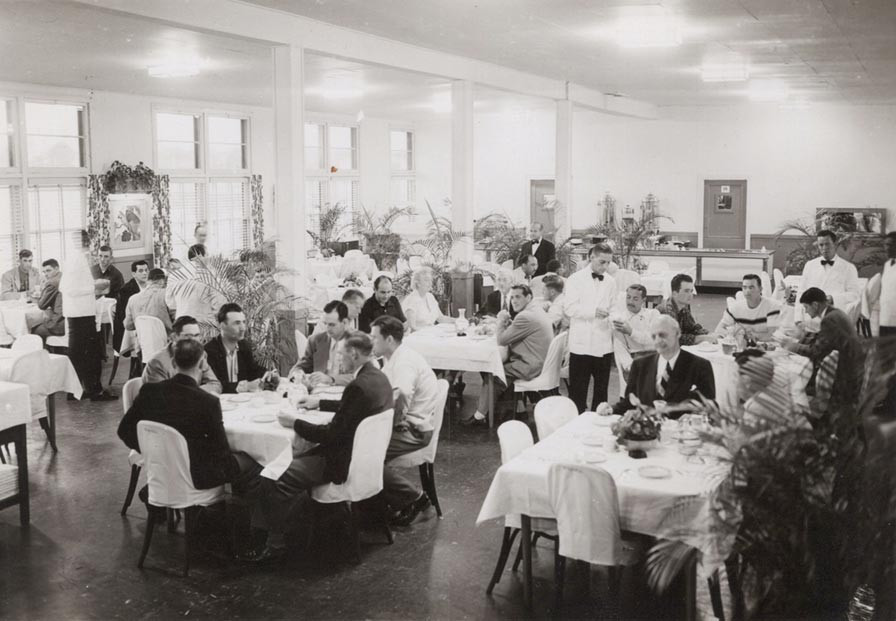
Walter O’Malley immediately upgraded the Dodgertown dining room after his ascent to President on Oct. 26, 1950. By spring training 1951, O’Malley had Dodger executives, major league players and the press dining on white linen tablecloths with a full service menu. However, when the minor league players descended on Dodgertown, dining service reverted to cafeteria style and O’Malley would wait in line with players from the various levels.
O’Malley upgraded the dining service, run by the Harry M. Stevens Company, who brought in their top chef Fred Boratto to work under dining chief Lester Webb. Dodger executives, major league players and the press ate on linen tablecloths and were able to order off a menu including steaks, loin lamb chops, broiled chicken, veal cutlet, roast beef and calves liver. He brought in a hospitality room in back of the kitchen.
He assigned venerable 30-year Brooklyn employee J. Julius “Babe” Hamberger to the hospitality room to greet and take care of the press and visiting dignitaries. Hamberger did virtually everything for the Dodgers, including traveling secretary, ticket seller, ticket taker, man the turnstiles, concessions employee, sweeper, scoreboard operator, groundskeeper, announcer, and clubhouse attendant.
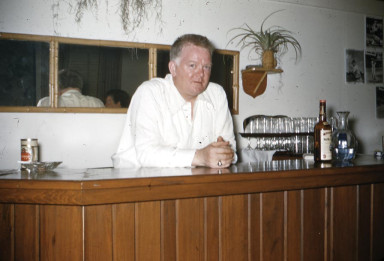
J. Julius “Babe” Hamberger takes care of the needs of the press and visiting dignitaries. Hamberger was assigned by O’Malley to handle greetings at the salon. Hamberger worked in several front office positions for the Dodgers over a 30-year career.
According to The Sporting News, March 22, 1950: “A sign on the door on the front of the Dodgertown dining room has this legend, ‘Through these portals passes three times daily the greatest and hungriest collection of diamond talent in the world.’” The Sporting News, March 22, 1950 Players and camp personnel consumed some 86 gallons of fresh orange juice each day of spring training that year.
Continuous newspaper and magazine accounts by writers with a dateline of VERO BEACH, FLORIDA gave the small town a huge boost of exposure at a time when the population was around 4,700 and there was nearly one Dodger player (major and minor league) for every seven residents.
A headline in The Sporting News in 1951 pronounced, “Bums Go From Rags to Riches at Camp,” as Dodgertown was enhanced under the leadership of O’Malley. On March 18, 1951, Vero Beach residents rejoiced over the dedication of the new $800,000 Merrill Barber Bridge, spanning the Indian River. Barber served as Vero Beach’s eighth Mayor from 1947-1949.
The Dodgers signed a 21-year lease agreement with the City of Vero Beach, whose officials had voted unanimously, to make Dodgertown their long-term Spring Training headquarters during the week of January 31, 1952. The agreement enabled the Dodgers to “renew for an additional period of 21 years.” No other major league club had a longer running spring contract. The terms of the lease were $1 a year for 21 years, which O’Malley, an attorney, paid upfront in cash.
It would be the first major statement that had been made by the Dodgers that indeed they were planning to stay. The terms “called for the Dodgers to have their team in Vero Beach at least 15 days each spring. A certain number of exhibition games were to be played, the Dodgers were to pay the city $3,000 to complete the debt on the competition-size swimming pool and earmark the entire receipts from one exhibition game for the airport fund.” A Vero vote of confidence and one appreciated by the local city fathers, who immediately realized the financial, public relations and hospitality impact of O’Malley’s commitment. Still, the majority of Dodger “home” spring games were played in Miami.
The March 13, 1952 Vero Beach Press Journal mentions, “President O’Malley has consistently stated that he has faith in the future growth of Vero Beach and the surrounding area. He feels that, in the future, Vero Beach and the surrounding area, will be in a position to support a larger exhibition schedule. If a large number of fans turn out and indicate that they want to see big league ball played in Vero Beach, Mr. O’Malley has assured them that they will get it.” Vero Beach Press Journal, March 13, 1952
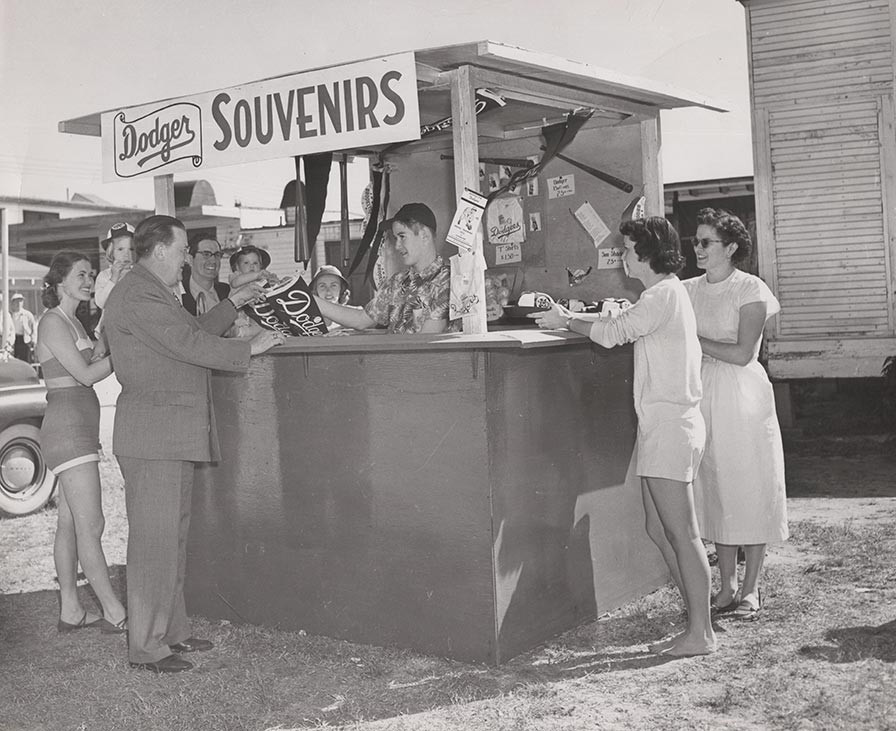
Brooklyn Dodger President Walter O’Malley purchases a Dodger souvenir pennant from his son, future President of the Los Angeles Dodgers, Peter O’Malley at Dodgertown in Vero Beach, Florida. Peter was named President of the Los Angeles Dodgers, March 17, 1970 at Dodgertown.
In 1952, as a teenager, Peter O’Malley was given the responsibility of operating the Dodgertown souvenirs kiosk on the base. As reported in the Vero Beach Press Journal, his first sale was made to his mother, Kay. The Brooklyn Daily Eagle added, “He was placed in charge of the new concessions booth and sold 100 rosters to the fans at yesterday’s workout.” Brooklyn Eagle, February 29, 1952
Walter O’Malley wrote to Chicago Cubs’ executive Wid C. Matthews on May 5, 1952 regarding the possibility of sharing a spring training site – today a common practice – in Vero Beach. The Cubs had just moved camp to Mesa, AZ, after seven years at Catalina Island, CA, in 1952. “We believe that two organizations could train in the same town if we had separate fields and eating and sleeping quarters. We would not be too much concerned about the problem of fraternizing. I have in mind we would give you a 21 year sub-lease or we might arrange to surrender those premises and have the new lease made out directly to your organization. You know from the general location that there is ample room for you to expand, should you wish.” Walter O’Malley letter to Wid C. Matthews, May 5, 1952 Shortly thereafter, Matthews responded to O’Malley and, though the offer was appreciated, the Cubs would maintain their present arrangement of training.
As more Black players took to the field in the 1950s, O’Malley wanted Dodgertown to provide an inclusive environment for everyone and their families and he strove to enhance the small college-like “campus,” provide comfortable accommodations and recreational opportunities for all, making it a town-within-a-town. At that time, the Southern states still abided under “Jim Crow” laws, including a “sunset curfew” for Blacks in Vero. The self-contained confines of Dodgertown were a protection from those who might not have welcomed Black players downtown.
In 1953, as a further gesture of the friendship with Vero Beach, O’Malley opened beautiful Holman Stadium, privately building a 5,000-seat ballpark with an adjacent heart-shaped lake as a valentine to his beloved bride, Dodger First Lady, Kay O’Malley. Using innovative construction, the sand, marl and muck used to form the lake was repurposed to create the stadium’s bowl, which was compacted and rolled before reinforced concrete was poured for the seating area. O’Malley had the lake stocked with fish.
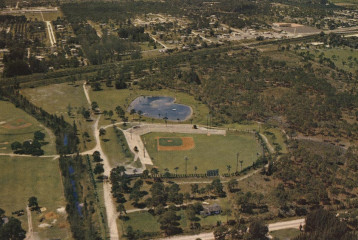
1959 postcard of heart-shaped lake and Holman Stadium in Dodgertown, Vero Beach, Florida.
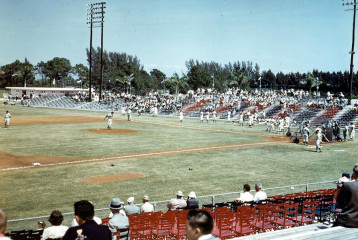
Batting practice at Holman Stadium in Dodgertown before an exhibition game. The individual chairs in the box seats were acquired from the Polo Grounds and Ebbets Field in New York.
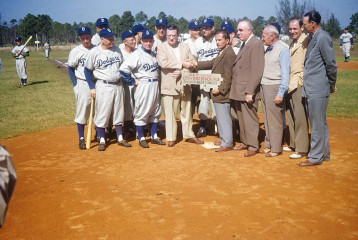
On the field at Holman Stadium, Dodgertown, Vero Beach, Florida in March, 1953, Dodger President Walter O’Malley receives a “Key to the City of Vero Beach.” Front row (L-R): Dodger Coach Jake Pitler; Dodger Manager Charlie Dressen; Walter O’Malley; Unidentified; Bud Holman, Vero Beach community and business leader; unidentified; Emil “Buzzie” Bavasi, Dodger Vice President; unidentified.
O’Malley desired a stadium which had perfect sightlines – no poles to obstruct the customer’s view of the field. He also wanted an intimate ballpark, especially capturing the feeling of bringing the players and fans close together during Spring Training. There were open dugouts and no outfield fences, just an embankment lined with Royal palm trees, donated by Mrs. May Smith in honor of her late husband John. After all, these were exhibition games that were to be played in Vero Beach.
O’Malley named the stadium for Bud Holman, who had been responsible for bringing the Dodgers to Vero Beach. O’Malley worked hand-in-hand with distinguished Navy Capt. Emil Praeger to engineer and design the new ballpark as a sort of “tryout” for the larger domed stadium O’Malley had in mind for the Dodgers to replace aging Ebbets Field in Brooklyn
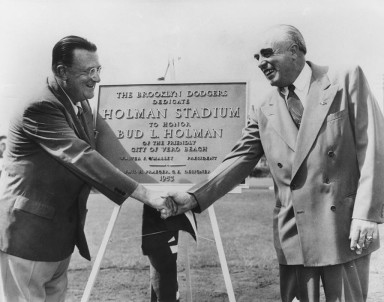
Walter O’Malley and Bud Holman shake hands at the dedication ceremonies for Holman Stadium on March 11, 1953. Though he became a rabid Dodger fan, initially Holman knew little about baseball. As an astute businessman, he saw and acted on the opportunity to bring the Dodgers to Vero Beach for spring training. The plaque presented by the Dodgers reads, “The Brooklyn Dodgers Dedicate Holman Stadium to Honor Bud L. Holman of the Friendly City of Vero Beach, Walter F. O’Malley, President, Emil H. Praeger, C.E., Designer, 1953.”
The city of Vero Beach could not have been prouder of new Holman Stadium, which was widely accepted by baseball officials and local fans. For Holman, the honor was one of civic pride in the small-town community, though his son Harry “Bump” Holman stated in a February 20, 1988 Vero Beach Press Journal interview about his father, “He really didn’t know anything about baseball.” Vero Beach Press Journal, February 20, 1988 However, Bud Holman knew spring training baseball was good for the community and he later became a rabid fan of the Dodgers.
Open Road magazine featured Dodgertown in their March, 1953 issue. The sub-head of the article reads, “Dodgertown, Brooklyn Dodgers’ own ‘little city’ in Florida, is the world’s largest and finest spring playground.” The article lists the features to be found there and states, “It is easy to see why the Dodger camp is called Dodgertown! On the Spring Training base, Dodger players and personnel had available medical facilities, post office, telegraph office, barber shop, movie theatre, swimming pool, a fish pond of two acres and a new baseball stadium with four practice diamonds and citrus groves all around. Dodger Vice President Fresco Thompson says of Dodgertown, ‘One month of concentrated training in Dodgertown is equal to a full year of baseball experience.’” Open Road magazine, March 1953
When the many minor league teams descended on Dodgertown and table service reverted to cafeteria style, the Dodger president and his wife Kay stood in line with their aluminum trays for food in the mess hall dining room along with everyone else. Class D ballplayers waited in line shoulder to shoulder with Class B, major leaguers and O’Malley himself. That was one of the most unique facets of Dodgertown and part of the reason for its success. This was no nameless, faceless organization, but one that gathered the “troops” together and made everyone feel a part of the larger family. By meeting and talking with the masses of individuals each day, the Dodgers became stronger and more unified.
“One of the main advantages of a central training camp is fraternization,” wrote VP Thompson in his book. “The players with all clubs become acquainted with one another; firm friendships develop. During the season if a player should be transferred from one club to another, or when the Dodgers cut down to their active limit of twenty-five, he goes to a club where he is not a stranger to the players or the manager.” “Every Diamond Doesn’t Sparkle: Behind the Scenes with the Dodgers,” Fresco Thompson, David McKay Company, 1964
The plan O’Malley devised for Dodgertown was to systematically upgrade the entire complex, maintaining the basic features that made it work from Rickey’s regime and enhancing it to become more player and fan friendly. He believed the more players felt at home at Dodgertown, by catering to their every need, the less likely they would wander off base for outside entertainment. O’Malley provided the most state-of-the-art spring training complex, with the best training techniques, meals, medical facilities, stadium, landscaping, and recreational facilities. A player might never leave base during his stay, except to attend a weekly religious service of his choice. And the Dodgers even provided bus transportation for that. Although the goal never changed: to win the championship, while addressing the well-being and conditioning of the players, and preparing them for the season using the best coaches to carry forward Dodger tradition.
“Spring Training at Dodgertown was something very special to me because of its rich history and the people who experienced Dodgertown,” said Hall of Fame Dodger pitcher Sandy Koufax. “It was a wonderful time. We were isolated there and players spent a lot of time together and we grew very close. When I got there, I had the opportunity to meet and play with so many great players – Duke Snider, Roy Campanella, Gil Hodges, Pee Wee Reese, Jackie Robinson, Don Newcombe, Carl Furillo and on and on. These were all the folks I rooted for in Brooklyn. I have so many great memories. Dodgertown is truly a historic place.” Press release, Historic Dodgertown, historicdodgertown.com, Sandy Koufax quote, 2013
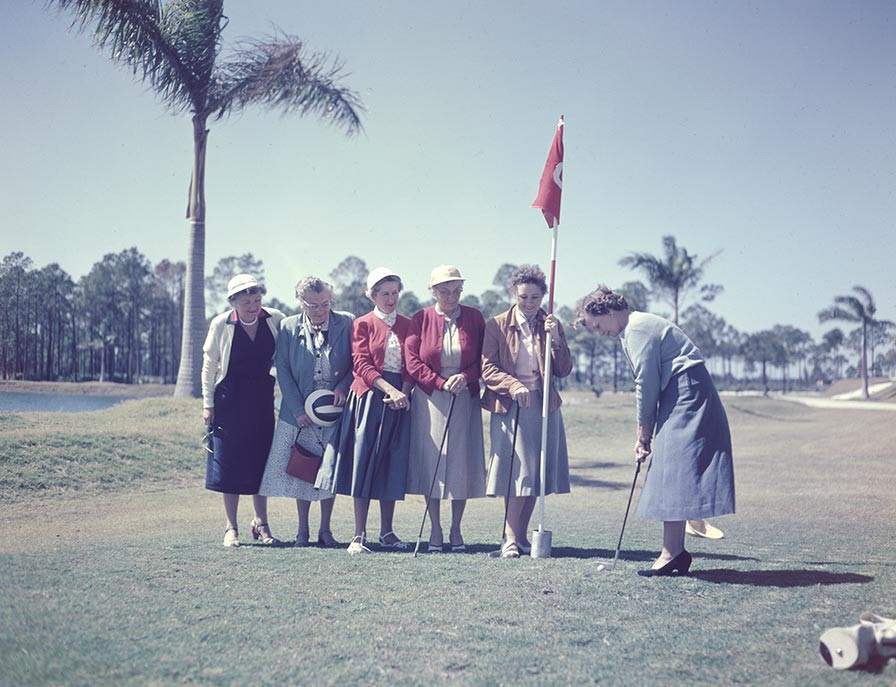
In March 1954, Walter O’Malley designed and opened a makeshift nine-hole pitch and putt golf course. Kay O’Malley, holding the flag, is joined by (l-r) Elizabeth Hickey, Edna Praeger, Peg Thompson, May Smith and Lela Alston.
O’Malley saw opportunity in Dodgertown, that the real beauty of it was that it could be a self-contained retreat, not just for a couple of months in the spring but with year-round possibilities. To that end, in 1954, O’Malley opened a makeshift pitch-and-putt golf course around the lake, as local courses were private, and he desired to give all his players and staff a chance for recreation without leaving the campus.
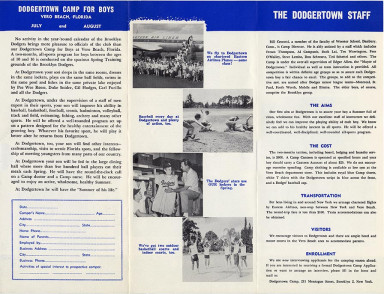
A brochure from the Dodgertown Camp for Boys, which was held in July-August at Dodgertown, Vero Beach, Florida, starting in 1954.
The same year, O’Malley initiated a Dodgertown Summer Camp for Boys. His daughter, Terry worked during several summers in camp administration as secretary for the camp director. Peter O’Malley served as a camp counselor as a teenager, helping to manage a group of 12-year-old boys out of about 200 boys (ages 10-16) from around the country who came to participate in a variety of sports and activities in July and August each year.
Starting on Day 1 of a new season, preparation during Spring Training helped to build championship teams. The first of six Dodger World Series championships was in 1955. After losing World Series battles to the rival New York Yankees in 1941, 1947, 1949, 1952 and 1953, the Dodgers finally prevailed in seven games, winning their title contest at Yankee Stadium, 2-0 on October 4, 1955.
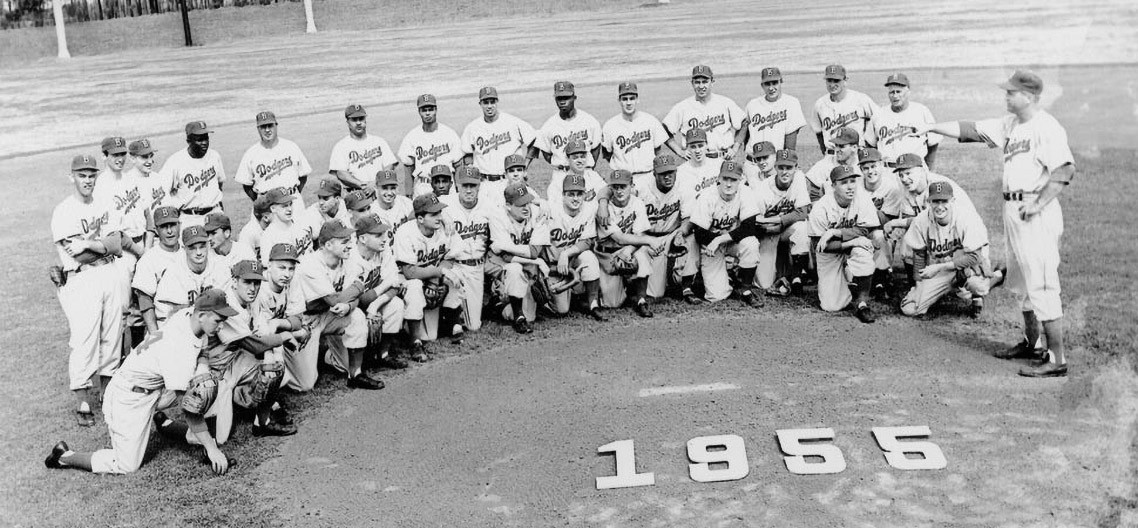
The team photo of the 1955 World Champion Brooklyn Dodgers at Dodgertown.
The next spring, O’Malley told the Vero Beach Press-Journal on February 16, 1956, “Once again, the Dodgers are at Dodgertown, Vero Beach. This time they are here as defending World Champions. Our long-sought goal has been reached. But now, we have an even greater problem – to stay on top of the baseball ladder. We are sure of one thing. We have the finest Spring Training base in the land – the most complete facilities imaginable, a great little ball park in Holman Stadium and the most cooperative neighbors in Florida. Last year the Dodgers won the World Championship right here in Vero Beach. It was the wonderful training we enjoyed here, the super condition of our players, which established Brooklyn immediately.” Vero Beach Press Journal, February 16, 1956 The Dodgers won 22 of their first 24 games in 1955 and were never headed.
Not only did the Dodgers start the 1956 season at Dodgertown, they won the National League Pennant for a second consecutive season. But, they concluded their season some 6,700 miles away from Brooklyn, as they went on a 19-game Goodwill Tour to Japan. It was a grand slam success. Because they believed that baseball had an opportunity to bring countries and individuals closer together through friendship, the O’Malley family would utilize Dodgertown as a bridge. Walter and Peter O’Malley constantly invited and welcomed international guests with open arms and were always willing to host those who wanted to learn more about baseball, exchange ideas, and observe training techniques used by the Dodger organization. Of course, the hosts found that learning was a two-way street.
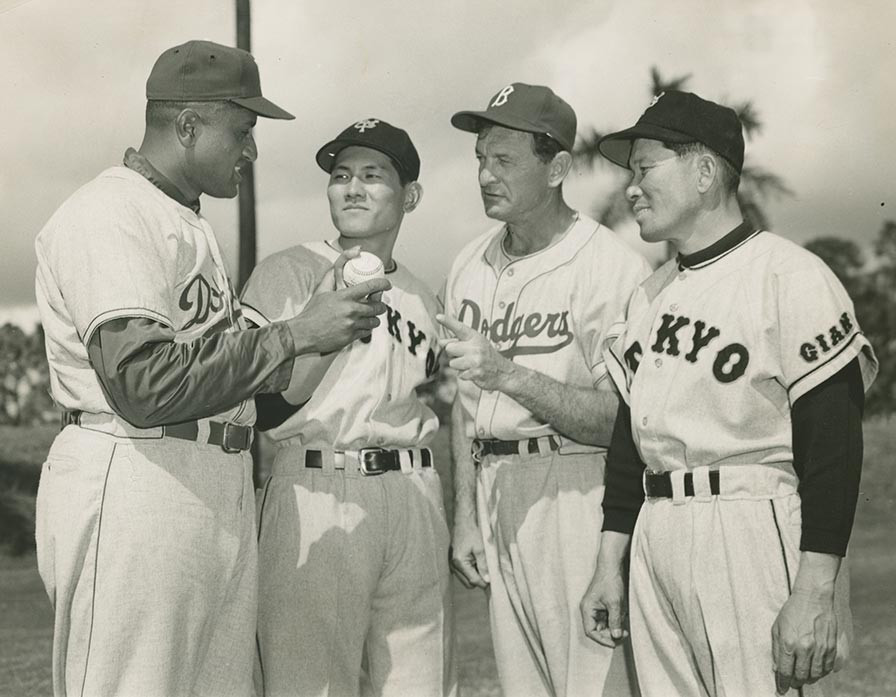
(L-R) Don Newcombe; pitcher Sho Horiuchi; Dodger pitching coach Joe Becker; catcher Shigeru Fujio. Don Newcombe shows a grip for one of his pitches to two Tokyo Yomiuri Giants players in 1957 Spring Training, as the Dodgers invited the two players along with the Giants’ Manager Shigeru Mizuhara to learn the Dodger way of playing baseball at Dodgertown, Vero Beach, FL.
The first Japan visitors to Dodgertown arrived in March, 1957, following the month-long Goodwill Tour there. The Tokyo Yomiuri Giants guests included Japan Baseball Hall of Fame Manager Shigeru Mizuhara, pitcher Sho Horiuchi, catcher Shigeru Fujio, and highly-respected Yomiuri Shimbun sports columnist Sotaro Suzuki, a Japan Baseball Hall of Fame member, who was confidant to Matsutaro Shoriki, Yomiuri founder and the “father of professional baseball in Japan”.
While the Dodgers were entertaining their guests from Asia, the West Coast of the United States was preparing to undergo change. The City of Los Angeles had long envisioned obtaining a Major League Baseball team to give more stature to the growing community. Rosalind Wyman, the youngest city councilmember at age 22, ran for a council position by including a campaign promise to “Bring Major League Baseball to L.A.” Wyman, a Democrat, enlisted the support of new Los Angeles Mayor Norris Poulson, a conservative Republican, to work together towards that end.
Wyman reached out to Walter O’Malley on September 1, 1955 requesting a meeting in New York, only to be frustrated by him that he would not meet her due to his on-going discussions with New York officials to remain in Brooklyn. His unprecedented 10-year effort to stay in Brooklyn, which had begun in 1946, continued as he was trying to find a solution to aging Ebbets Field and its limited and scattered parking for 700 cars. O’Malley also pointed out that Los Angeles already had two Pacific Coast League teams – the Los Angeles Angels and the Hollywood Stars – and he did not want to interfere with their operations.
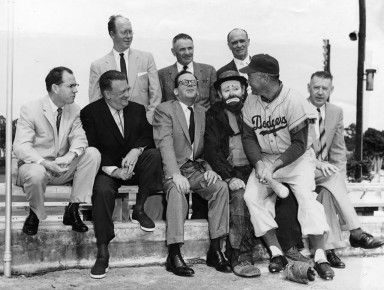
Front Row (L-R) Los Angeles County Supervisor Kenenth Hahn; Walter O’Malley; Los Angeles Mayor Norris Poulson; Clown Emmett Kelly; Duke Snider; John Gibson, Los Angeles City Councilman. Back Row: John Leach, City of Los Angeles Assistant Administrative Officer; Milton Arthur, Chairman, Los Angeles Parks and Recreation; Samuel Leask, City Administrative Officer. Clown Emmett Kelly and Dodger outfielder Duke Snider with Dodger President Walter O’Malley greet Los Angeles city officials on their visit to Dodgertown to encourage the Dodgers to relocate to Los Angeles, March 6, 1957.
But, that did not deter Wyman from continuing her intense pursuit of the Dodgers. Eventually, Mayor Poulson and a small entourage from Los Angeles visited Dodgertown on March 6, 1957 to see if they could convince O’Malley to bring his Dodgers west. Still unconvinced, O’Malley listened but had his sights focused on privately building a new domed stadium for the Dodgers in Brooklyn at his preferred location at the intersection of Flatbush and Atlantic Avenues, today the site of Barclays Center, home of the Brooklyn Nets.
O’Malley understood that fans wanted and deserved a better facility to replace Ebbets Field, one which would provide comfortable and unobstructed seats, ample parking and options for convenient public transportation. All modes of transportation merged at Atlantic and Flatbush Avenue and a new parking structure could have accommodated fans at the proposed domed stadium.
But, the commitment of Los Angeles to bring baseball to the other coast was obvious. Only after exhausting all possible options in Brooklyn, did O’Malley make the decision to relocate to Los Angeles at the conclusion of the 1957 season. New York City master planner Robert Moses did not support the concept of assembling land, which O’Malley needed and was prepared to purchase. After negotiations started with L.A. in earnest in late August, 1957, the city of L.A. made an agreement with O’Malley, which obligated him to privately finance, build and maintain a new 50,000 seat stadium. The contract also called for him to initially pay $345,000 in property taxes, putting the land on the tax rolls for the first time in many years, and develop a youth recreation center on the land at $500,000 initially plus annual payments of $60,000 for 20 years. In addition, he exchanged Wrigley Field in L.A., appraised at $2.2 million to the city.
Starting in Spring Training, 1958, the Dodgers would wear a new cap, one with an interlocking “LA”. The New York Giants moved in tandem to San Francisco, changing the baseball landscape forever. In 1959, the Dodgers bounced back from a seventh place National League finish a season earlier to win the World Championship, their first in L.A.
Even though the Dodgers switched coasts, Vero Beach remained the one constant, a place called “home” for two months of Spring Training that had a special and familiar feel to it. Dodgertown employees who remained through the years became friends of the ballplayers, staff and front office, unifying each camp.
While O’Malley had his hands full with the business matters in Los Angeles, especially his efforts to initially find a place to play and then finally build his dream stadium there, Dodgertown continued to thrive. In 1957, Piper Aircraft Company arrived in Vero Beach and established a research and development center where part of the Naval Air Station had been located. The additional industry helped the area’s growth as a resort town.
In 1961, when Japan’s professional Tokyo Yomiuri Giants made their first team visit to Dodgertown, it was Peter O’Malley who was responsible for all arrangements and schedule for the Giants from their arrival to departure. It was then that he bonded with two of the Giants’ all-time great players – Sadaharu Oh and Shigeo Nagashima. Dining room menus were printed in Japanese for the occasion. The Giants would return for training in 1967, 1971, 1975 and 1981. After four of their visits to prepare for the season, the Giants won the Japan Series. Peter’s strong ties to Vero continued with his first full-time job upon graduation from The Wharton School at the University of Pennsylvania. He was named Director, Dodgertown starting January 1962, a position he held for three years.
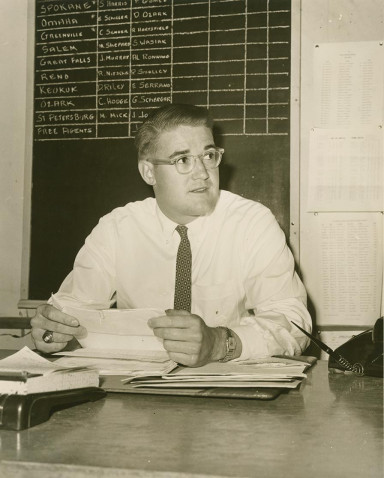
Peter O’Malley was named Director, Dodgertown , Vero Beach, Florida in 1962. He spent three seasons running the Spring Training camp, his first job upon graduation from the University of Pennsylvania.
On August 7, 1961, Frank Scott, Director of the Major League Baseball Players Association wrote to Walter O’Malley about the problems that exist during Spring Training to house all players under one roof at MLB camps in the south. He asked O’Malley for a brief summary. O’Malley responded on August 8: “Your letter of August 7th, I believe might be sort of in the nature of a form letter as it actually does not apply to our club which trains at Dodgertown, Vero Beach. You will recall from your visits that all our players, office staff, executives, directors and owners are housed and eat under one common roof. There are local city ordinances that are not in keeping with our thinking which, however, cover situations off our self-contained base. Our relations with the local political administration are not cordial at the moment and we have even been giving some thought to transferring our base to the West Coast unless we see signs of improvement.”
Black Dodger players approached Dodgertown Director Peter O’Malley early in the spring of 1962 about the seating and facilities at Holman Stadium that were separate. O’Malley immediately integrated Holman Stadium for all fans, standing on the back of Head Groundskeeper Bob Summers’ truck, painting out signs that read “Blacks Only” for seating, restrooms, and drinking fountains. Players like Tommy Davis and Jim Gilliam were instrumental in encouraging Black fans to relocate from seats down the line to behind the plate. This was seven years prior to the integration of Vero Beach public schools.
“My first job after college was to run Dodgertown during the offseason and then set it up and staff it,” said Peter O’Malley. “It was owned by the city and I remember I painted in signs that said ‘white’ and ‘black’ or ‘Negro’ for different restrooms. That got my attention and that’s vividly in my mind. I remember the early years at Holman Stadium, the black fans all sat down by the bullpen and the white fans sat between the bases. We changed that gradually. We got the word out that everybody’s welcome to sit everywhere. That was in the early ’60s.” Jon Santucci, Press Journal, April 13, 2014
One of the players who met with Peter O’Malley was Tommy Davis. “Peter, Jackie Robinson integrated this thing in 1947, and we still have a problem at Holman Stadium, right now…He kind of said, ‘What?’ It didn’t dawn on him at the time. But to his credit, the next day everything was gone. They white-washed all that stuff. And we had to physically take the black people to seat them in other spots around the stadium. When we had an exhibition game we went and took the people out of the right field area and told them to sit in left field, sit behind home plate, sit over there. And they wouldn’t believe us. ‘Oh no, we can’t do that,’ they said. So we just took them and told them to sit wherever they wanted to from now on. That was the integration of Holman Stadium.” “Tommy Davis’ Tales From The Dodgers Dugout”, Chapter, “Race Relations”, Sports Publishing, LLC, 2005
Los Angeles-based columnist Melvin Durslag writing in The Sporting News on April 11, 1962, “Where seating in the baseball stadium here has always been segregated, Walter O’Malley removed the signs this year, inviting Negroes to sit anywhere in the park. Perhaps 99 per cent continue to occupy the old Jim Crow seats but, slowly, more are expected to make the shift. In town, O’Malley’s popularity hasn’t thickened.” Melvin Durslag, The Sporting News, April 11, 1962
Dodger shortstop Maury Wills, who toiled eight and a half years in the minor league system, knew every nook and cranny of Dodgertown. In 1959, Wills finally made the major leagues when he learned to switch-hit and he helped lead the Dodgers to the World Championship. In 1962, Wills stole 104 bases, breaking the then major league modern-era record of 96 set by Ty Cobb in 1915. Wills faced prejudice squarely in the face in Vero Beach, but over the years it became a favorite place.
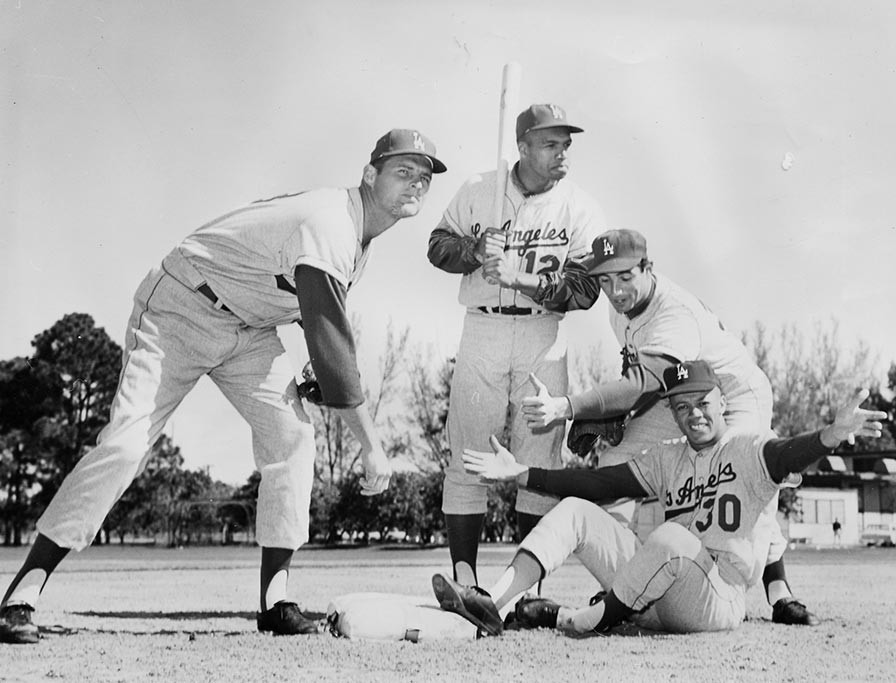
(L-R): Don Drysdale; Tommy Davis; Sandy Koufax; and Maury Wills, circa 1963 at Dodgertown, Vero Beach, Florida. The four players had superb 1962 seasons with Drysdale winning the Cy Young Award with 25 victories; Koufax won 14 games and was considered one of the best left-hand pitchers in the game; Tommy Davis led the National League in hitting with a .346 average. Maury Wills was the 1962 National League Most Valuable Player and stole 104 bases to set a then major league record.
Wills said, “I came here in 1951 and was here long enough to see the world change, people change, and I’ve been here long enough that I’ve got some lifelong friends in Vero of all ethnicities.” Ross Newhan, Los Angeles Times, February 10, 2008
As Dr. Jerald Podair, professor of history and American Studies at Lawrence University in Appleton, WI wrote for his article, “Haven of Tolerance”: Dodgertown and the Integration of Major League Baseball Spring Training: “Civil rights was the great American moral cause of the 20th century. Dodgertown’s contributions make it just not a great sports story, but a great American one.”
Jimmy Powers, writing in the New York Daily News noted about Peter O’Malley’s first year as Dodgertown Director, “Walter O’Malley’s 24-year-old son, Peter, is climbing up the executive ladder, gaining the wisdom, experience, and maturity that will eventually qualify him as the next owner of the club. Young O’Malley immerses himself in all phases of baseball – press and radio relations, selling scorecard advertising, redecorating and refurbishing Dodgertown, hiring and directing personnel, handling airplane reservations, setting up concessions and keeping the books.” Jimmy Powers, New York Daily News, June 4, 1962
On September 23, 1964, the Dodgers purchased 110.4 acres of airport land, building and improvements for $133,087.50 from the City of Vero Beach. The agreement, approved by the Federal Aviation Agency, benefited the city’s general fund as the land went on the tax rolls. Prior to the Dodgers’ first spring exhibition game in Vero Beach on March 13, 1965, Mayor Jack Sturgis presented Dodger President Walter O’Malley with a deed to the land at Dodgertown. The Dodgers became the only major league club in Florida to own and maintain their own Spring Training site. In later years, the Dodgers purchased another 340 acres to enlarge their base.
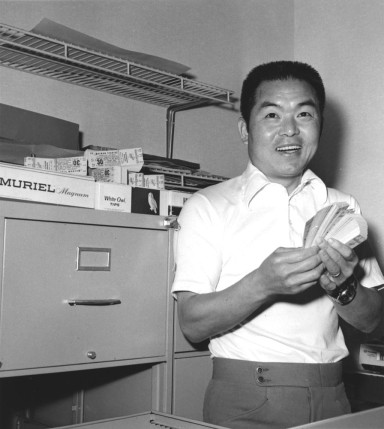
Akihiro “Ike” Ikuhara, a graduate of Waseda University in Japan, working in the Dodger ticket office. Ikuhara learned the business of baseball from the O’Malleys and became a goodwill ambassador and interpreter for the Dodgers. In summer of 2002, Ikuhara was posthumously inducted into the Japan Baseball Hall of Fame.
In 1965, Walter O’Malley hired Akihiro “Ike” Ikuhara, a graduate of prestigious Waseda University in Tokyo to work in various departments and learn the business of baseball. He was highly-recommended by O’Malley’s friend Sotaro Suzuki of Yomiuri. On the Dodgers’ second Goodwill Tour to Japan following their appearance in the 1966 World Series, the highly-educated and respected Ikuhara served as a team ambassador and interpreter. Ikuhara would later work with Peter O’Malley in Spokane, Washington and then for 25 years at Dodger Stadium. Ikuhara wrote two baseball books printed in Japanese (“The Man Who Survives the Race” in 1984; “A Winning Tradition” in 1985) and in summer of 2002 was posthumously honored with induction into the Japan Baseball Hall of Fame.
In 1965, the Dodgers hired two minority major league coaches – Jim Gilliam, the popular African American Dodger infielder and Preston Gomez of Cuban descent – a first in Major League Baseball. The Dodgers went on to win the 1965 World Championship.
In the mid-1960s, Kay O’Malley suggested honoring friends of the Dodgers and Dodger “family” members who worked at Dodgertown and had passed by holding a Memorial Mass at Dodgertown each spring. This way of respecting and remembering the departed continued every Spring Training for decades. Son Peter said, “All the things we did like the Memorial Mass were important pieces to the framework of Dodgertown.”
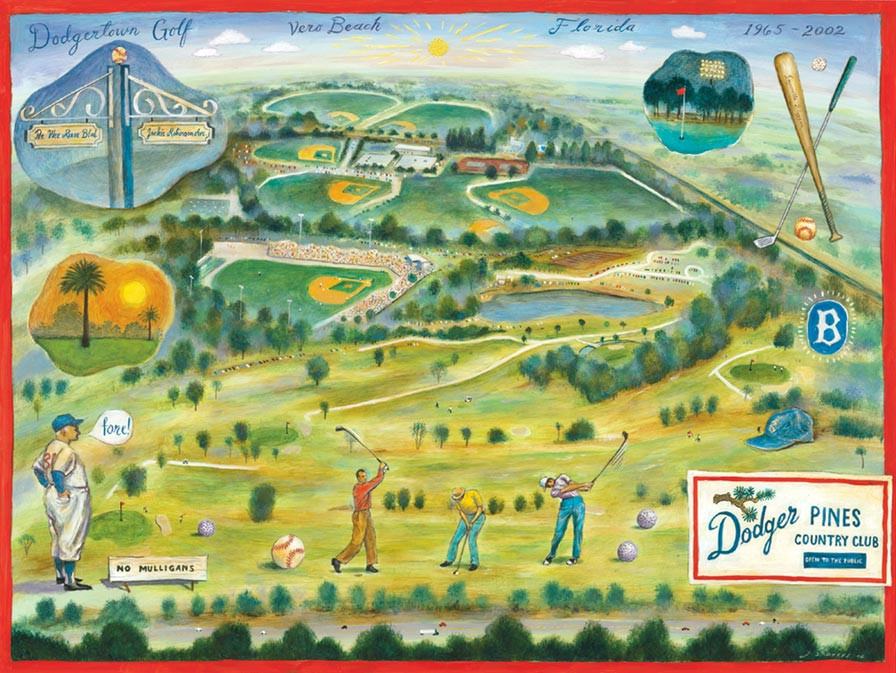
After baseball, one of Dodgertown’s most popular activities for players and executives alike was golf. Walter O’Malley built two golf courses on the Dodgertown property (a nine-hole course in 1965 and an 18-hole course in 1971). This John S. Dykes illustration celebrates the golfing fun at Dodgertown.
Walter O’Malley expanded his golf holdings in 1965 to a nine-hole course, “Dodgertown Golf Club” surrounding the heart-shaped lake. It was the first public golf course in Vero Beach and was dedicated in the spring of 1966. In 1971, O’Malley, serving as architect and designer of the course, along with Ira Hoyt, unveiled an 18-hole public golf course, initially named “Safari Pines Country Club” and later renamed, “Dodger Pines Country Club”. That course dedicated in spring, 1972 featured a rare and challenging 670-yard, par-6 on hole No. 3. All of this to offer Dodger players, including African Americans who were not welcomed on local private courses, and staff an opportunity to enjoy their leisure hours after baseball in a controlled and friendly environment.
“Dodgertown is unique,” said Peter O’Malley. “Because it was a community within a community, the major and minor league players were housed and dined together, frequently interacting, which brought everyone together at this most important time of the year. African American players were excluded from playing on the two existing local golf courses, so my Dad privately built two golf courses – a nine-hole and an 18-hole – enabling all the players to participate.” Historic Dodgertown, Vero Beach, Florida official press release, February 25, 2015
Two-time National League batting champion Tommy Davis said, “Mr. (Walter) O’Malley knew that we liked to play golf, so he built us a nine-hole golf course at Vero Beach. Well, it was for everybody, but we played on that course so much it felt like it was built for us, meaning the black guys in the Dodger organization. The best thing about it, though, was it kept us in Vero Beach, because if we kept driving all over Florida searching for golf courses that would let us play, sooner or later, somebody would have gotten in trouble.” Ibid.
The O’Malley family continued developing, expanding, maintaining and modernizing Dodgertown throughout the decades. Peter O’Malley was named Dodger President at Dodgertown during a directors board meeting in the old barracks the morning of St. Patrick’s Day, March 17, 1970, succeeding his father Walter, who became Dodger Chairman of the Board.
Walter and his wife Kay were horticulturalists. They cultivated award-winning exotic orchids in greenhouses both in Amityville, New York and Los Angeles. Walter even took a rake and helped to smooth out the infield the night before Holman Stadium was dedicated. In 1966, in conjunction with the Florida and Pelican Island Audubon Societies, Walter and Kay established Dodgertown Wildlife Sanctuary to protect vast species of native birds. Walter had planted hundreds of sun-ripened grapefruit trees in a grove at Dodgertown. Son Peter took Dodgertown to the next level by nourishing it. The grounds were impeccably manicured amongst the flora and fauna. Blooming colorful flowers and plants were prevalent on walkways and in front of Holman Stadium giving it a beauty befitting a floral expo more than a baseball complex.
In the spring of 1971, the Tokyo Yomiuri Giants returned for training alongside the Dodgers. Walter O’Malley was impressed.
“We’ve brought the Japanese teams to the Dodgers’ spring training camp a number of times, and the Japanese are students of the game,” said Walter O’Malley. “They work.” Ed Schoenfeld, The Sporting News, November 6, 1971
Don Drysdale, who was a Hall of Fame Dodger pitcher and a Dodger broadcaster, said on his return to Dodgertown in the spring of 1971: “The camp at Vero was just super. Everyone was under one roof. All those minor (league) players were working and living with the major leaguers. Whenever they finished their drills or workouts for the day, they would have to go and watch the big leaguers finish. When the big team played intersquad games, we had to sit in the stands and watch. You had to learn that way. You see how much a couple of young fellows with this camp are learning. Well, at Vero (Beach), every kid in the organization had that chance.” Ian MacDonald, The Sporting News, March 27, 1971
In 1972, the next major project was to build new accommodations to replace the old Naval barracks. That brought about a mock campaign to “Save the Barracks”! Anyone who stayed in the barracks recalls that the walls were paper thin; many bathrooms were “down the hall”; multiple roommates bunked in the rooms; there was no heating or air conditioning, which made conditions uncomfortable; and, in the early years, each morning camp mailman and night watchman Herman Levy would run the American flag up the pole and audibly state the Pledge of Allegiance. Then he would blow his shrill whistle to wake everyone up in the barracks to get the day started.
Despite these “inconveniences,” no one would have traded the atmosphere of camaraderie, whether in the lobby just conversing or shooting pool or getting a snack at the canteen. It was still like a military-style base where there was really no place to go except to see an occasional movie or listen to a baseball instructional lecture in the old auditorium.
But, the 89 modern accommodations opened in 1972 were clearly an upgrade for all concerned and the barracks, with all their history, were eventually torn down in their entirety by Big Chief, Inc. of Ft. Lauderdale in 1976 to make way for further expansion. For the first time, everyone had heating, air conditioning, phones and a television in their room. Also, in 1972, the Dodgers surrendered the lease on two practice fields to cooperate with neighboring Piper Aircraft so that it could expand the manufacturer’s plant operation. In 1974, the O’Malley family added a new administration building, encompassing 23,000-square feet, which included housing the Major League clubhouse, medical department, dining room, kitchen, main lobby, broadcasting studio, photo darkroom, press room, lounge, training rooms, equipment room, minor league clubhouse and laundry room. In 1976, clubhouses were built for the two golf courses.
A large banner welcoming those who were staying on base said it all, “IT’S GREAT TO BE IN DODGERTOWN”!
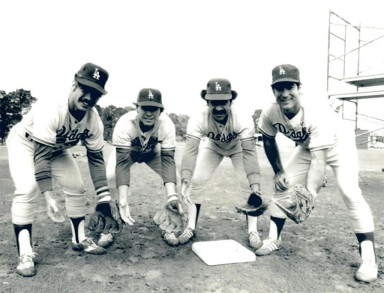
The record-setting Dodger infield (from left) of third baseman Ron Cey, shortstop Bill Russell, second baseman Davey Lopes and first baseman Steve Garvey.
The Dodgers featured a record-setting infield in the 1970s and 1980s comprised of Steve Garvey at first base, Davey Lopes at second base, Bill Russell at shortstop and Ron Cey at third base. That quartet played together from June 23, 1973 until the final game of the 1981 World Series on October 28, won by the Dodgers against the New York Yankees, 9-2.
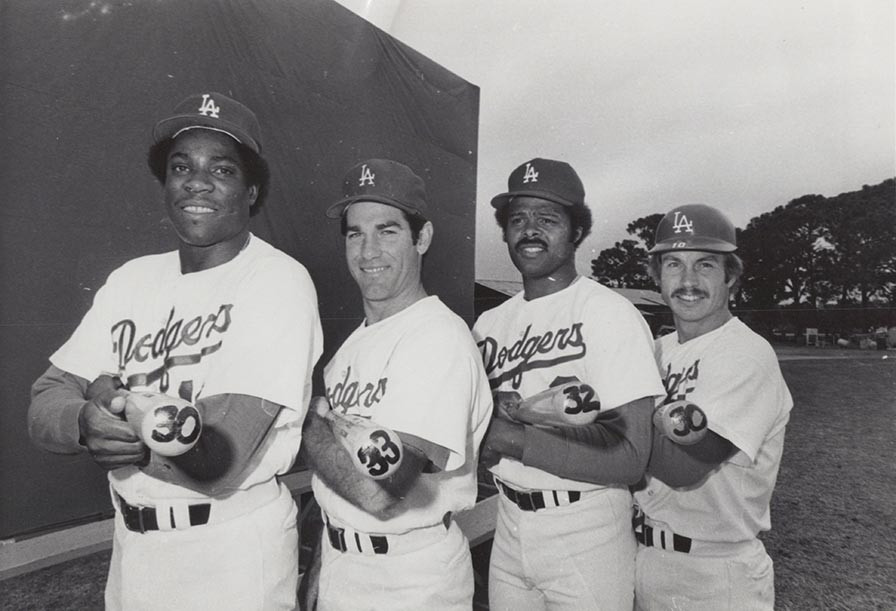
(L-R): Dusty Baker; Steve Garvey; Reggie Smith; and Ron Cey. The four Dodger players who set a major league record by each hitting 30 or more home runs in the 1977 season. That had never been achieved in major league history.
“Dodgertown was the ideal spring training facility for us,” said Cey, tri-MVP of the 1981 World Series. “It gave us a great comfort level with everything that was going on. Everything you needed to succeed at baseball was at your fingertips and you didn’t have to worry about anything else, other than preparing for the season and hopefully winning a championship.”
Russell who trained at Dodgertown for 20 seasons agreed, “I always looked forward to going to Dodgertown for spring training. It was a wonderful atmosphere and put you in a great frame of mind to start a new baseball season and give you the confidence you needed to try to win a championship.”
Garvey, a spring training batboy for the Brooklyn Dodgers who as a youngster frequently rode the team bus with his father the bus driver, said, “With Dodgertown, the O’Malley family created the ultimate environment from which to cultivate, develop, and nurture their ideal of what a professional franchise should be.”
Former major league manager Lopes added: “Dodgertown was ahead of its time as a baseball training complex. Dodgertown was Vero Beach. It was a like a town. It had everything. You never had to leave the grounds.”
The O’Malley family-owned Dodgertown was the heartbeat of Vero Beach. The recognition from stories with a Vero Beach dateline was enormous for the community which had steadily grown to more than 12,000 residents in the 1970s.
In 1975, Dodgertown Director Charlie Blaney suggested naming streets at Dodgertown in recognition of three Dodgers enshrined in the Baseball Hall of Fame in Cooperstown, New York. Thus Jackie Robinson Avenue, Roy Campanella Boulevard and Sandy Koufax Lane were created. As additional Dodgers were elected to the Hall of Fame, they were honored with streets named for them on site, including Duke Snider Drive, Pee Wee Reese Boulevard, Don Drysdale Drive, Vin Scully Way, Tommy Lasorda Lane, Don Sutton Court and Avenida Jaime Jarrin. Hall of Fame Manager Walter Alston had a main meeting room named for him.
In 1977, the Dodgers hired Harrison Conference Services to manage the 450-acre campus and add important conference business for year-round activities, including meetings and seminars. The distraction-free environment with all-inclusive on-site activities was very popular for companies from around the country.
Where once major and minor league baseball training was the sole focus of Dodgertown, in later years, the O’Malley family expanded into the conference center business, Summer Camp for Boys, golf courses, citrus groves, real estate development, and summer training camp home for the National Football League’s New Orleans Saints for 10 years (1974, 1976-1984).
When longtime Vero Beach tourist destination McKee Gardens was closed due to declining attendance in 1976, Peter O’Malley purchased the centerpiece of the “Hall of Giants,” the 35-foot, one-piece mahogany table from the Philippines in 1980. For 23 years, it was in his possession until McKee Botanical Gardens re-opened to the public and O’Malley loaned the table to once again be displayed in the “Hall of Giants.” In 2022, O’Malley donated the unique table to McKee. On St. Patrick’s Day, 1952, Walter O’Malley and his executives and guests celebrated with a big party at McKee Jungle Gardens around the enormous table. At an occasion such as this, with a twinkle in his eye, Walter O’Malley would remind his guests, “Half the lies they tell about the Irish aren’t true!” St. Patrick’s Day parties at Dodgertown became legendary.
“St. Patrick’s Day was the only event of the spring under my Dad,” said Peter O’Malley; “It was well known in the industry to be at Dodgertown on March 17. Everyone looked forward to it – staff, secretaries, visitors, league presidents, commissioners would be in Vero Beach. No players were invited. It started in the old Recreation Hall, then to the restaurant and we brought it nearby to the dining room which could seat about 150 people. Different people emceed it and performers played and sang Irish music. The place was well decorated from the lounge to the dining room. We awarded the Key to Dodgertown to some well-deserving individuals, including friends and longtime front office personnel. We even held an Irish sweepstakes where gifts were given and a trip to Ireland!”
Blaney and Peter O’Malley created “Christmas at Dodgertown” as more and more player wives and their families were coming to Dodgertown. Since the Dodgers were not together in December, O’Malley believed in bringing the Christmas spirit to all. It was an instant hit, as each child of a Dodger player received a gift hand-selected just for them. Santa Claus in his red suit arrived on a local fire truck to delight the children. It became the most anticipated event of the spring for Dodger players and their families. Peter also added additional themed events poolside such as the “Western Barbecue” and “50’s Night”. All of these were designed to bring the families together, have fun and break up the monotony of a long spring schedule. To modify the same look of the main dining room for the executives, staff and coaches during the weeks of Spring Training, O’Malley asked for decorations for themes such as “Italian Night” or “Seafood Night”.
“In spring training, there was Christmas at Dodgertown, where the coaches wives and the other members of the front office went shopping for the little kids,” said Dodger pitcher Jerry Reuss from 1979-1987. “They got a Santa Claus, had snow out there and the kids actually experienced Christmas – in March! Where do you find snow in Florida to put out by the swimming pool for the kids and bring Santa in, so they all get gifts? The most incredible thing I had ever seen. My kids still talk about it. It went even better from there – even though we were living ‘off-campus’ as I like to refer to it, Peter O’Malley would still have a barbecue where everybody could get together and visit. That means the front office people, the people who had been with the Dodgers for who knows how many years, and the players, their wives, families could meet socially. That was rare, because rarely did you have all of those people in one place.”
Walter O’Malley passed away on August 9, 1979, a mere 28 days after his beloved wife Kay passed. That made Peter O’Malley and his sister, Terry O’Malley Seidler, jointly responsible for the Dodgers.
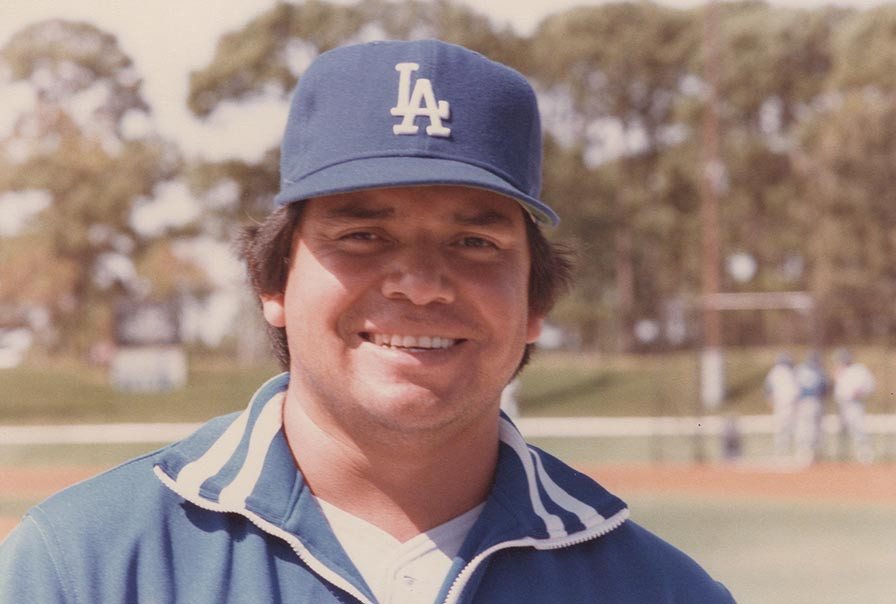
Fernando Valenzuela electrified baseball during the 1981 “Fernandomania” season. Selected as the Dodgers’ Opening Day starting pitcher in 1981, he threw a shutout, becoming the first Dodger rookie pitcher to pitch a shutout on Opening Day. From there, he went on to win eight straight decisions and five of them were shutouts.
Fernando Valenzuela, the Mexico-born player that Walter O’Malley had always hoped for, was signed just two months before the visionary Dodger president passed. Nineteen-year-old Valenzuela came to the Dodgers from the Double-A San Antonio team late in the 1980 season and immediately made his presence felt. But it was beginning the 1981 season that his career soared as he won his first eight games, five of them shutouts and had a 0.50 ERA. It was the beginning of “Fernandomania” from coast to coast and throughout Mexico. He became the biggest hero and fans snapped up every ticket to watch him pitch wherever he started. Fernando became the first player to win both the Cy Young Award and the Rookie of the Year award in the same season.
“I get very emotional when I think about Dodgertown and my first spring training,” said Fernando. “It was great for a rookie who just wanted to play baseball. It has everything you could possibly want to get ready for the season. You can eat, sleep and train there and never have to go anywhere else. It brings back a lot of good memories for me.”
In 1980, the Single-A Vero Beach Dodgers were established by O’Malley and Blaney and played home games at Holman Stadium in their inaugural Florida State League season. The Vero Beach Dodgers won the Florida State League Championship in 1983 and repeated as champions in 1990. The Dodgers also initiated their Adult Baseball Camp during the off-season of 1983 for aspiring players who used all the Dodgertown facilities and received expert instruction while staying and dining on base. It was the first of 53 popular camps held at Dodgertown through 2014. Loyal campers made the pilgrimage to Dodgertown every year because of the bonds of brotherhood.
In 1990, a state-of-the-art indoor batting tunnel and Spring Training office building were added. The next year, the Stadium Club Lounge was renovated and two full size fields (Nos. 5 & 6) joined the campus, as adjacent land was acquired and an exchange made with the City of Vero Beach.
During Peter O’Malley’s years, Dodgertown was named the best Spring Training site by Baseball America publication in 1993 and again in 1998. Dodgertown truly was a jewel and O’Malley knew how to keep it polished for all to enjoy.
On February 19, 1994, pioneer pitcher Chan Ho Park, the first South Korean-born player to participate in Major League Baseball, made his debut in the batting cages as rain prevented him from pitching in Holman Stadium. Park’s MLB debut was on April 8, 1994 in Atlanta. He won 124 games in 17 MLB seasons, including 9 with the Dodgers.
From 1994-2001 and 2008, Park pitched for the Dodgers, earning MLB All-Star honors in 2001 after posting a 15-11 record with 3.50 ERA. He then went on to play for six teams. In 2010 while pitching for Pittsburgh, Park picked up his 124th victory, passing Hideo Nomo as the pitcher with the most wins by an Asian-born player. As a pioneer from South Korea, Park opened the door for 25 more players (as of the 2023 season) from his native country to play in MLB.
O’Malley invited close friend Renzo Ishii, a Japan Baseball Hall of Fame Manager, and his 1994 baseball team from prestigious Waseda University, Tokyo to Dodgertown. Waseda became the first amateur club to train alongside the major league Dodgers during Spring Training.
The next spring, another historic event took place as Hideo Nomo came to Dodgertown as the first Japan-born player to don a major league uniform in 30 years. The difference was that Nomo committed to staying and completing his career in MLB. O’Malley signed Nomo on February 13, 1995 as a free agent. Every move that Nomo made from the time he reported to Dodgertown for his first Spring Training to the final game of the 1995 season was closely chronicled by hordes of media from Japan and the United States. Despite the pressure and burden of being constantly observed by the press corps and a nation back home, Nomo maintained a calm demeanor and significantly produced on the field for the Dodgers. He was known as “Warrior” as a fierce competitor on the mound, who had a corkscrew style of delivery.
Like Park, Nomo wanted to challenge the best hitters the world had to offer in the major leagues. Nomo was selected as the starting pitcher for the 1995 All-Star Game in Texas and struck out three in two scoreless innings. “Nomomania” was born and, after going 13-6 with a 2.54 ERA in 28 starts, he was named 1995 National League Rookie of the Year, the fourth consecutive Dodger in a string of five to earn that distinction. He became a role model for school-aged children and the biggest hero imaginable in Japan.
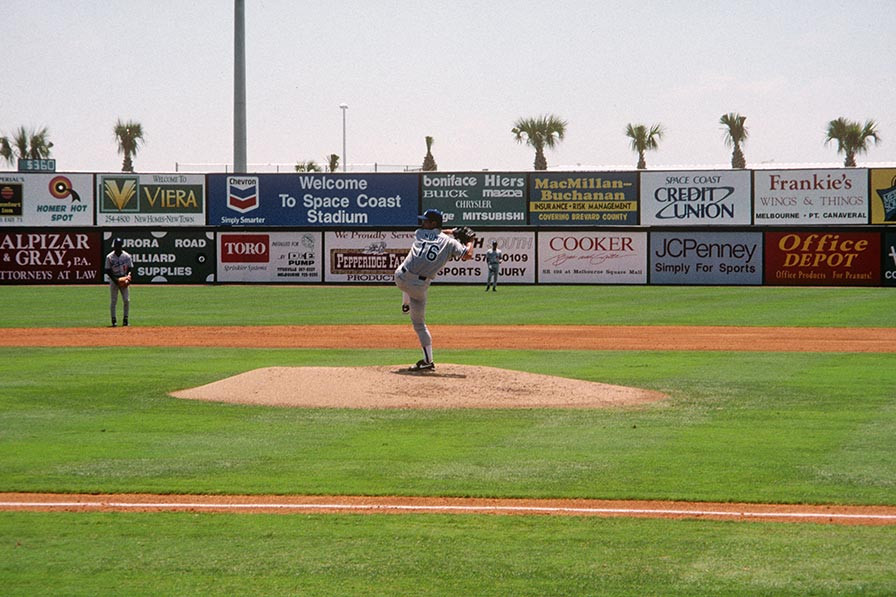
Aprll, 22, 1995 Hideo Nomo of the Los Angeles Dodgers pitches in an exhibition game against the Florida Marlins in Viera, Florida, the Marlins’ Spring Training base.
He won 123 games in 12 major league seasons, plus 78 more for the Kintetsu Buffaloes in Japan, where he started his career. Nomo pitched for the Dodgers from 1995-1998 and 2002-2004. His popularity was historic, as his homeland watched every start on giant television screens placed on buildings and on street corners in 13 major cities. No matter when the game started, it was televised live in Japan. Dodger Stadium was packed for his starts and he filled National League stadiums when he pitched. Nomo pitched two career no-hitters, one of only five major leaguers to achieve that feat in both the National and American Leagues.
Nomo was inducted into the Japan Baseball Hall of Fame on July 18, 2014 in ceremonies held prior to the Nippon Professional Baseball All-Star Game at Seibu Dome in Tokorozawa (near Tokyo), Japan. Nomo became the youngest player elected to the Japan Baseball Hall of Fame at age 45 and 4 months on January 17, 2014. O’Malley was in Japan to participate in the induction ceremonies in support of his friend Nomo.
“Nomo and Park are both true pioneers,” said O’Malley. “They opened the door for more players from Japan and South Korea to participate in Major League Baseball. Today, there have been 60-plus players from Japan and 20-plus players from South Korea (as of the 2023 season) who have played in the major leagues. I am very proud of their leadership and their on-going commitment to youth baseball in Japan and South Korea.”
Nomo recalled the care that O’Malley provided to him at Dodgertown, “Every day after practice, Peter O’Malley would sit down with me and ask how things were going and if everything was OK. Without his kindness, I would have emotionally struggled through Spring Training. I am still so grateful to Mr. O’Malley for the kindness and care that he gave me. I remember at the end of Spring Training, Mr. O’Malley would host a family barbecue party where there was a merry-go-round and animals. It felt like an amusement park. That atmosphere was one that I had never experienced in my life, and most importantly, that was the moment that it felt like the ‘Dodgers.’” John Santucci, Stuart News, March 6, 2015
O’Malley sold the Dodgers to the Fox Group in 1998 and he stayed on through the rest of that year as Dodger Chairman of the Board. In 2001, Fox sold Dodgertown (land and buildings) to Indian River County. The Dodgers under the ownership of Frank McCourt pulled up their 60-year roots in Vero Beach, moving their spring headquarters to Glendale, Arizona in 2009. Dodgertown was then shuttered as Indian River County officials tried to figure out what to do with the land without a baseball team. Dodgertown remained shuttered for nine months until Minor League Baseball transformed the site into a multi-sport training center named “Vero Beach Sports Village”.
Minor League Baseball experienced heavy losses for two and a half years and the former Dodgertown was on the brink of being shuttered by Indian River County for a second time. Fortunately, the story has a happy ending because that’s when Peter O’Malley raised his hand and decided to become responsible for the campus. In a 2012 partnership with his sister, Terry O’Malley Seidler, and former Dodger star pioneer pitchers Chan Ho Park and Hideo Nomo, O’Malley saved Dodgertown from closing, became the operating entity, embraced and celebrated its glorious history and began its transformation of training and development for a new generation.
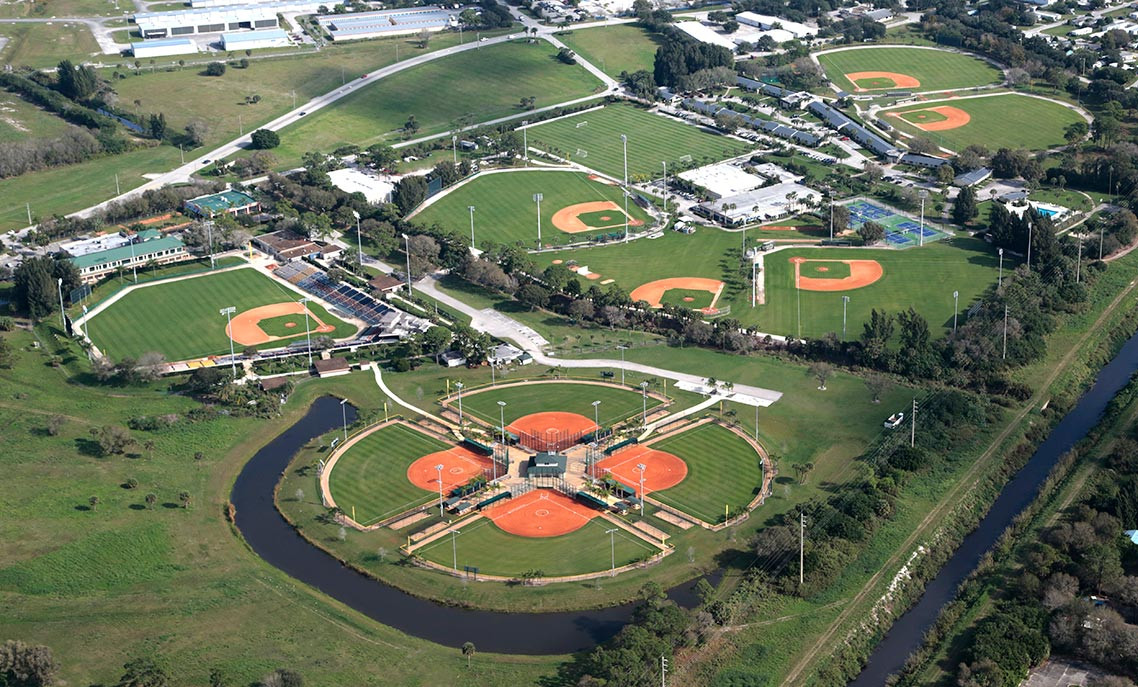
An aerial view of Historic Dodgertown – Vero Beach, Florida with its added fields for softball and youth baseball in the foreground, adjacent to iconic Holman Stadium.
In 2012, a beautiful new quad built by Indian River County for softball/youth baseball fields was added and a multi-purpose field (110 x 130 yards) that could facilitate football, lacrosse, soccer and rugby was also established.
The site was booked year-round by all those sports – and more like swimming and rowing – for training. That brought a total of 10 ½ fields, seven which were lighted. O’Malley announced, on August 29, 2013, a name change of the campus to honor Dodgertown’s world-famous stature when it was established as “Historic Dodgertown – Vero Beach, Florida.”
Historic photographs, magazines, memorabilia, text and labels were added to rooms named for Jackie Robinson, Roy Campanella, Championship Hall (honoring and celebrating the six Dodger World Championships – 1955, 1959, 1963, 1965, 1981 and 1988), the Stadium Club Lounge (Sports Illustrated covers recognizing the Dodgers through the years) and the Dining Room (enlarged magazine covers featuring Dodgers players and events). Also, Campy’s Bullpen where catcher Roy Campanella held court to tell stories to cooks, players and broadcasters on a regular basis was established as a landmark of Dodgertown. A Hall of Fame baseball card wall at Holman Stadium recognizing more than 140 players, managers and executives from the U.S. and Japan who had played or appeared at Dodgertown was created in 2016. All this was to showcase and share Dodgertown’s unique history.
Celebrities ranging from President George H.W. Bush, Danny Kaye, Rev. Billy Graham, Eddie Rickenbacker, Nat King Cole, George Jessel, Perry Como and Ray Bolger to Jane Fonda, Spike Lee, Bryan Cranston, Ivan Lendl and Jake Owen have all graced Dodgertown’s hallowed grounds. Nine of 10 Baseball Commissioners have stayed or visited, with Judge Kenesaw Mountain Landis, the first Commissioner, the only exception as he passed prior to the site opening.
In November 2014, during the 53rd Los Angeles Dodgers Adult Baseball Camp at Historic Dodgertown, the site was recognized by the state as a “Florida Heritage Landmark” and a permanent marker was placed on the path leading to the original main conference building and dining room. The marker celebrates “Baseball and Dodgertown” and the significant activities that took place, as Dodgertown was Major League Baseball’s first fully-integrated Spring Training site in the South.
In 2015, Dodgertown was named “Large Company of the Year” by the Indian River County Chamber of Commerce for its impact in the community as a year-round destination.
The fourth generation of the O’Malley family enjoyed Vero Beach during Thanksgiving week when they joined second and third family generations for a reunion at Historic Dodgertown, hosted by Terry O’Malley Seidler and Peter O’Malley. They welcomed their children and grandchildren to Vero Beach from November 25-28, 2015.
“Starting with our parents’ first visit to Vero Beach, Historic Dodgertown has been our home away from home,” said Peter O’Malley. “My sister Terry and I want to introduce our grandchildren to this very special place and community.”
On March 21, 2016, in honor of Bruce Froemming, who at that time was the longest tenured Major League Baseball umpire for consecutive service at 37 seasons, Historic Dodgertown officially named its umpire room the “Bruce Froemming Umpire Room”. A biography and photos of Froemming adorn the walls of the umpire room and a sign was placed on the exterior door. Froemming served 12 years in the minor leagues, 1958-1970.
O’Malley said, “This is well-deserved recognition of Bruce’s extraordinary career and now and forever he will have his name on the umpire room. Bruce had the respect of players and fellow umpires. We first connected when I was Dodgertown camp director in the early 1960’s and Bruce was a minor league umpire in the Northwest League. We’ve been friends for a long time.”
In 1970, Dodger President Walter O’Malley encouraged National League umpire Al Barlick to allow Froemming, then a minor league umpire, to work behind home plate for a major league Dodgers-Washington Senators exhibition game at Holman Stadium. After that game, Washington Manager Ted Williams praised Froemming for his excellent work. Froemming’s first season in the N.L. was 1971. For convenience during Spring Training, five to 10 professional umpires stayed at Dodgertown, working both major and minor league games.
In 2018, Historic Dodgertown was heavily used by youth, amateur and professional teams, including the SK Wyverns (2018 Champions of the professional Korean Baseball Organization); the Minor League Baseball Umpire Training Academy; the Canadian Football League Montreal Alouettes; MLB Elite Development Invitationals for baseball and softball; Baseball and Softball Factory; innovative Your Call Football; and the 5th Annual Jackie Robinson Celebration Game featuring two Florida State League teams in a regular season contest at Holman Stadium. Some 40,000 visitors and 1,100 teams were welcomed to the campus each year, while more than 32,000 hotel rooms were booked annually in Vero Beach and Indian River County as a result of games and training at Historic Dodgertown.
In his book “101 Baseball Places to See Before You Strike Out,” author Josh Pahigian wrote, “The centerpiece of Dodgertown was, and still is, Holman Stadium – one of the most delightful little ballparks pro ball has ever known, simply because there is so little about it that resembles a professional park. What you will notice is that the complex sees nearly year-round use now as starry-eyed youths, collegians, and adults play and practice on the very fields once graced by giants of the game like Pee Wee Reese, Jackie Robinson, Don Drysdale, Sandy Koufax, and Fernando Valenzuela.”
“The O’Malley name is synonymous with Dodgertown,” said former Dodger pitcher Burt Hooton said in 2007 at the Dodger Adult Baseball Camp. “As long as I’ve been associated with this organization, and there’s always been good people in it as long as there has been an O’Malley running it. I take that from Walter, from Kay to Peter O’Malley and (his wife) Annette O’Malley. When you talk Dodgertown, it’s family. If you put that Dodger uniform on, you became part of a family. Peter O’Malley saw to that, Terry Seidler, his sister, saw to that. All of the O’Malley’s saw to that. They understood the rigors and difficulties of winning a World Championship. Yet, every time I came to spring training here that was our goal was to win a World Championship…That’s what we worked for. Everybody worked to that end, to the point where we won some along the way. Rest assured, the O’Malley’s hover over this place (Dodgertown). For myself and I know I am speaking for everybody else who ever put that Dodger uniform on, or whoever worked for the Dodgers, it is a real blessing in our lives to be able to do that.”
In December, 2018, O’Malley found a successor to be responsible for the Historic Dodgertown site that he had been looking for in Major League Baseball. MLB officials had utmost regard for the campus for its many tournaments and training camps, particularly in the development of youth baseball and softball. MLB signed a long-term lease with Indian River County to ensure the future of Dodgertown. O’Malley turned over the keys willingly knowing that MLB would continue the site’s tradition of training, instruction, inclusiveness and diversity.
On April 2, 2019, MLB renamed the campus, Jackie Robinson Training Complex, to pay homage to the man that originally made Baseball diverse as its first Black player in 1947. Robinson’s uniform number 42 was universally retired by MLB on April 15, 1997, on the 50th Anniversary of Robinson’s Dodger debut. But that was 25 years after Robinson visited Dodger Stadium for pregame ceremonies in which the O’Malley family retired his uniform number on June 4, 1972. Jackie’s widow Rachel Robinson and two of her children Sharon and David attended the press conference with Baseball Commissioner Rob Manfred and Peter O’Malley.
On January 31, 2019, Historic Dodgertown was named to the U.S Civil Rights Trail for its significant role in U.S. Civil Rights history. The U.S. Civil Rights Trail is a collection of churches, courthouses, schools, museums and other landmarks primarily in the Southern states where activists challenged segregation in the 1950s and 1960s to advance social justice.
Historic Dodgertown is the only sports property on the U.S. Civil Rights Trail, and is featured alongside famous sites and cities such as Dr. Martin Luther King’s birthplace in Atlanta; the Edmund Pettus Bridge in Selma, Alabama; the Greensboro, North Carolina, Woolworth’s where sit-ins began; and the National Civil Rights Museum at the Lorraine Motel in Memphis, to name a few other prominent locations.
“Dodgertown, Vero Beach played a pioneering role in advancing rights for African Americans starting in 1948 and continuing throughout the 1950s and 1960s,” said O’Malley. “All of us connected to Dodgertown and its legacy are extremely proud of this well-deserved recognition by the U.S. Civil Rights Trail organization.”
For 60 years, the Dodgers gathered at Dodgertown to prepare for the upcoming season. Team members included Hall of Famers Jackie Robinson and Roy Campanella, Dodger greats Don Newcombe, Jim Gilliam, Joe Black, Maury Wills, Tommy Davis and John Roseboro. Local youth who came to watch these legendary players began to see the possibilities of integration and have hope for their own futures. The Dodgers played on the same fields in use today by youth, amateur and professional athletes who regularly visit the former Dodgertown and are literally walking in the footsteps of greatness.
“Major League Baseball is the ideal leader for Dodgertown’s next chapter,” O’Malley said. “Commissioner Rob Manfred and his colleagues understand the historical significance of this unique place and they’ll do an excellent job being responsible for it. The people of Vero Beach and Indian River County will be very proud of having Major League Baseball members of their community.”
On February 3, 1954, Dodger President Walter O’Malley wrote a letter to Charles Jewett, the City Manager of Vero Beach, Florida, of his vision for Dodgertown, which started a Summer Camp for Boys that July: “Sometimes I wonder if people really appreciate just how serious and proud we are to have the largest baseball training camp in the world located in Vero Beach. I know a number of my associates thought I was going soft when I decided to build a stadium in Vero Beach on property that we did not even own. I felt that the stadium would be a fine monument to the City of Vero Beach even if the Dodgers for some reason moved elsewhere.
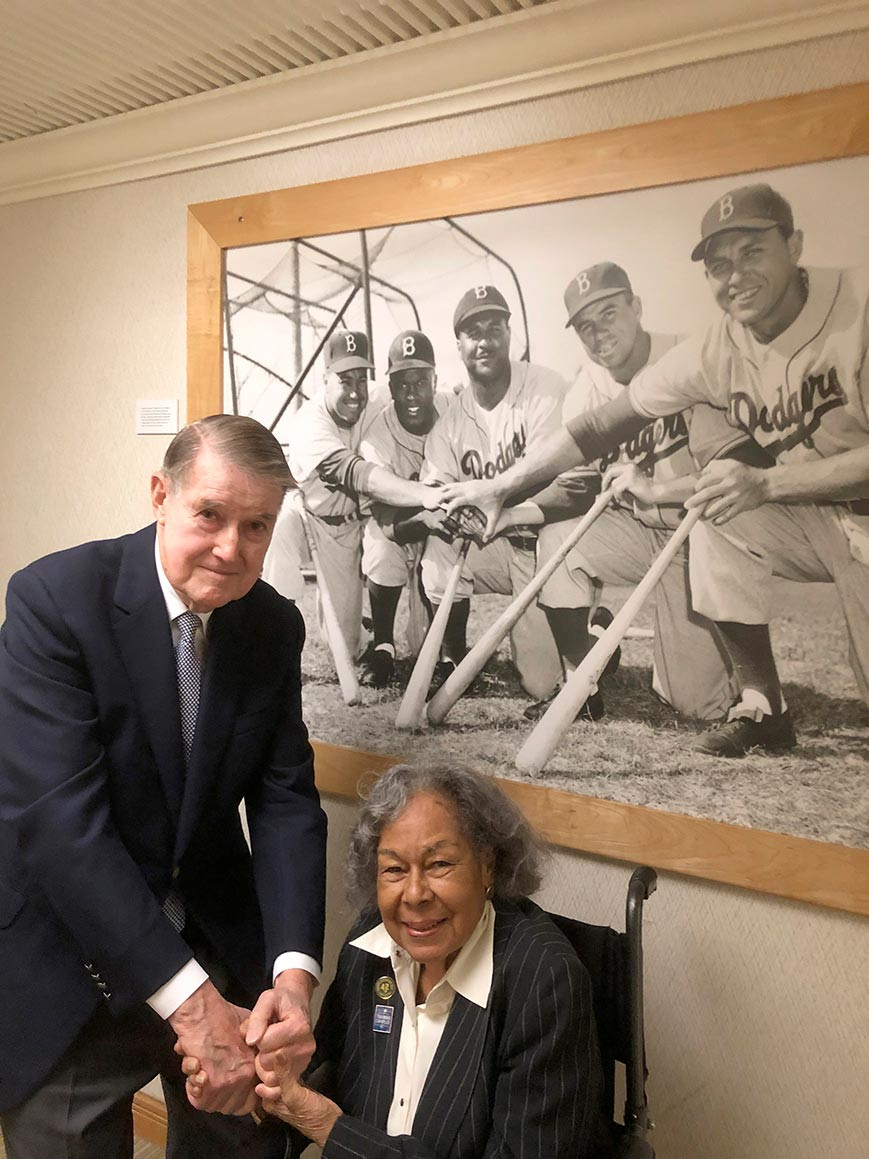
On April 2, 2019, Peter O’Malley and Rachel Robinson on the day that Historic Dodgertown – Vero Beach, Florida was renamed and dedicated the Jackie Robinson Training Complex by Major League Baseball.
Photo by Darrell Miller
“We have enjoyed excellent cooperation and understanding with the people of Vero Beach and we shall do everything possible to continue that fine relationship…I am enclosing a schedule of the games that we propose to play in Vero Beach this spring. With a few exceptions these games are reported back to the various cities of the participating clubs under Vero Beach date lines. This, of course, is terrific and wholesome publicity…I believe the year will come when one of the great umpire schools will be located at Dodgertown as well as pre-spring training clinics for the amateur leaders of Little League and amateur junior baseball. All of these I believe are steps in the proper direction and I do hope the civic response is cordial as it always has been.”
Baseball Commissioner Manfred said on April 2, 2019 during the renaming of the campus, “This place is also a special place. The O’Malley family built Dodgertown as a model for Major League Baseball. In addition to Jackie Robinson, people like Don Newcombe and Roy Campanella, pioneers in their own right, trained here. This place will always have an important part of our history. So, I think it’s fitting that we combine the legacy of Jackie Robinson and the legacy of this important facility by renaming Historic Dodgertown, the Jackie Robinson Training Complex.”
Reflecting on Dodgertown, Peter O’Malley said, “It wasn’t only me that loved it. Everybody did. You would walk around those pathways and bump into the players, wives, coaches, writers, trainers. It was like a small college campus, and it brought everyone together at that critical time of the year. There’s just too much history to let it disappear. David Waldstein, New York Times, April 17, 2015 It’s special to me because I know the history. I know the background on Campy’s bullpen. I know the pitching strings area where Drysdale and Koufax, and many other pitchers would practice. I know the batting cages where Duke Snider and Roy (Campanella) hit. It’s special to me because I know what was here.” Jamal Collier, MLB.com, November 14, 2014


